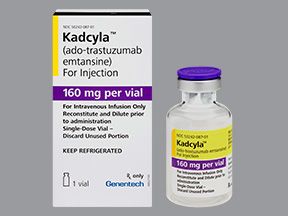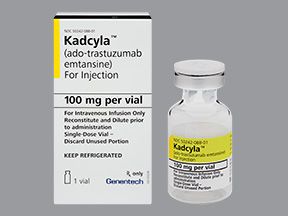If you have a certain kind of breast cancer, your doctor might suggest Kadcyla as a treatment option for you.
Kadcyla is a prescription drug that’s used to treat certain kinds of HER2-positive breast cancer that’s early stage or metastatic in adults.
The active ingredient in Kadcyla is ado-trastuzumab emtansine. An active ingredient is what makes a drug work.
This article describes the dosages of Kadcyla, as well as its strengths and how the drug is given. To learn more about Kadcyla, including details about the kinds of HER2-positive breast cancer it treats, see this in-depth article.
Note: This article covers Kadcyla’s standard dosages, which are provided by the drug’s manufacturer. But your doctor will prescribe the Kadcyla dosage that’s right for you.
Below you’ll find information on Kadcyla’s usual dosages and administration. Your doctor can tell you more about the right dosage for you.
What form does Kadcyla come in?
Kadcyla comes as a powder in single-dose vials. It’s mixed with a liquid to make a solution for intravenous (IV) infusion (an injection given into a vein over time). A healthcare professional will give the infusion.
What are Kadcyla’s strengths?
Kadcyla comes in two different strengths:
- 100 milligrams (mg)
- 160 mg
What are the usual dosages of Kadcyla?
Your doctor will calculate your dose of Kadcyla based on your weight and other factors. These may include any health conditions you have and how your body reacts to treatment with Kadcyla.
The standard starting dose of Kadcyla is 3.6 mg per kilogram (mg/kg) of body weight. (1 kg is about 2.2 pounds.)
Dosage for early stage breast cancer
For treating early stage breast cancer, Kadcyla treatment follows a 21-day cycle. You’ll receive a dose of 3.6 mg/kg once every 21 days (3 weeks).
You may have up to 14 cycles of Kadcyla. How many cycles you will receive depends on whether the drug is working effectively for you or causing serious side effects.
Your doctor will monitor how you’re doing with Kadcyla treatment for as long as you’re receiving the medication. In some cases, you may need a dose reduction. Your doctor will discuss with you your exact dosage and any dosage changes.
Dosage for metastatic breast cancer
For treating metastatic breast cancer, Kadcyla treatment follows a 21-day cycle. Your dosage will likely start at 3.6 mg/kg once every 3 weeks. You’ll receive infusions for as long as the drug is working to treat your cancer and you don’t have serious side effects. Your doctor will monitor you carefully during treatment.
You may need a dose reduction in some cases. For more information, see the “Dosage adjustments” section below.
Is Kadcyla used long term?
Yes, Kadcyla may be used as a long-term treatment. If you and your doctor determine that Kadcyla is safe and effective for you, you may receive treatment with Kadcyla long term.
Your doctor will discuss how long you’re likely to receive Kadcyla to treat your condition. This may be based on the severity of your condition, other medications you may take, and other health conditions you may have.
Dosage adjustments
In some cases, you may need a dosage reduction. This depends on how you react to treatment with Kadcyla. If you have serious side effects, your doctor may lower your dosage to see how you do. If you still experience serious side effects, they may permanently stop Kadcyla treatment.
Your doctor may adjust your dosage if you:
- develop problems with your liver
- have heart failure, lung problems, or a certain kind of nerve damage
Your doctor will discuss with you the reasons your dosage may need adjustment.
The dosage of Kadcyla you’re prescribed may depend on several factors. These include:
- if you have serious side effects
- your body weight
- other conditions you may have (see “Dosage adjustments” under “What is Kadcyla’s dosage?”)
- other medications you may be taking
You’ll receive Kadcyla at your doctor’s office or a clinic. A healthcare professional will give you the drug as an intravenous (IV) infusion. This is an injection given into a vein over time.
The first time you receive Kadcyla, your infusion will likely take 90 minutes. The healthcare professional will monitor you during this time for infusion-related side effects. These may include fever, chills, and other serious reactions. You’ll continue to be monitored for 90 minutes after the infusion is complete.
After this, your infusions will likely take 30 minutes. You’ll be monitored for side effects during this time and for 30 minutes after your infusion. But if you had a reaction during your first infusion, you may continue to have 90-minute infusions.
If you have an infusion-related reaction to Kadcyla, the healthcare professional may slow or stop the infusion either temporarily or permanently.
Your doctor’s office will usually set up appointments for your Kadcyla infusion. If you miss an appointment, call your doctor’s office to reschedule. You and your doctor can also discuss whether your dosing schedule will need changes.
To make sure you don’t miss an appointment for your Kadcyla dosage, try marking your appointments on a calendar. Or you can download a reminder app to your phone.
The sections above describe the usual dosages of Kadcyla provided by the drug manufacturer. If your doctor recommends this drug to treat your breast cancer, they’ll prescribe the dosage that’s right for you.
Before you start receiving Kadcyla, it may be helpful to ask questions about your treatment. Here are some questions you may want to ask your doctor about Kadcyla’s dosage:
- Will you lower my dosage if I have side effects from Kadcyla?
- If I’m taking other medications, will this affect my dosage?
- Will a lower dosage still be effective in treating my cancer?
If you have breast cancer, you can get news on treatments and advice for managing your condition by signing up for Healthline’s online newsletter. Or join Healthline’s breast cancer community for insights and support from others living with breast cancer.
Q:
If I have liver problems, will this affect my dosage of Kadcyla?
AnonymousA:
Yes, it’s possible. Kadcyla can cause your liver enzyme levels to increase, which could damage your liver. If you already have liver problems, your risk of liver damage from Kadcyla increases. The drug may also cause liver failure, which can be life threatening.
In fact, this drug has a boxed warning about the risk of serious liver damage.
Before you start receiving Kadcyla, your doctor will check your liver function. They’ll also do this during treatment with Kadcyla. Based on this monitoring, they may adjust your dosage of the drug.
If you experience symptoms of liver failure, contact your doctor right away. Possible symptoms include jaundice, dark-colored urine, nausea, and loss of appetite.
In certain cases, your doctor may lower your dose of Kadcyla and see how you do. If you still have liver function problems or liver damage, they’ll likely stop your Kadcyla treatment.
The Healthline Pharmacist TeamAnswers represent the opinions of our medical experts. All content is strictly informational and should not be considered medical advice.Disclaimer: Healthline has made every effort to make certain that all information is factually correct, comprehensive, and up to date. However, this article should not be used as a substitute for the knowledge and expertise of a licensed healthcare professional. You should always consult your doctor or another healthcare professional before taking any medication. The drug information contained herein is subject to change and is not intended to cover all possible uses, directions, precautions, warnings, drug interactions, allergic reactions, or adverse effects. The absence of warnings or other information for a given drug does not indicate that the drug or drug combination is safe, effective, or appropriate for all patients or all specific uses.


